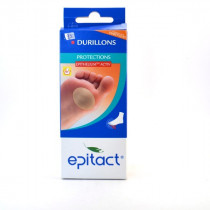Double action: * Protects the skin * Relives pain linked to calluses when walking The smallest of plasters for calluses * Very thin and discrete; they can be worn in all open or closed shoes * SUITABLE FOR DIABETICS Indications of Epitact Epithelium Activ Callus Plasters Calluses under the feet Description of Epitact Epithelium Activ Callus Plasters * Pack of 3 self-adhesive plasters, 4.5x3.8cm. * The Epithalium Activ gel spreads out the pressure, adhesive properties (no glue). * Hand washable (water and soap) and reusable (an average of 5 times) plasters. * Skin becomes suppler and hydrated. How to use Epitact Epithelium Activ Callus Plasters Apply onto the affected area. After use, put the plaster back into its box to retain its properties. How do calluses form? Skin is composed of 3 layers from the outside to the inside: epidermis, dermis, hypodermis. The epidermis is made up of cells called keratinocytes which are formed in the basal layer of the skin. Over time the keratinocytes come towards the surface of the skin, die and then disappear (by desquamation). In normal circumstances there is an equal balance between new cells forming and old ones dying. However when there is too much pressure put onto the skin, it cause a defence reaction which leads to an increase of new cells. The normal desquamation is not sufficient enough and so therefore there is a thickening of the cornea layer (most external layer of the skin). These often painful injuries are called ‘calluses’ when they are under the foot and ‘corns’ when they are on the toes. How to treat calluses? The natural balance between the production of new cells and desquamation must be restored by removing repeated pressure or small traumas. For this it is better to put a plaster in between the skin and the aggressor (shoe) for comfort.




